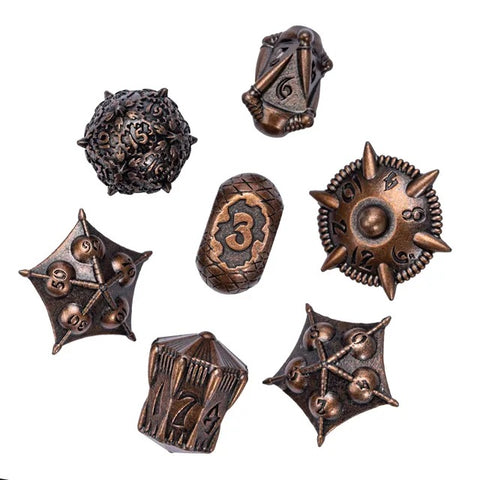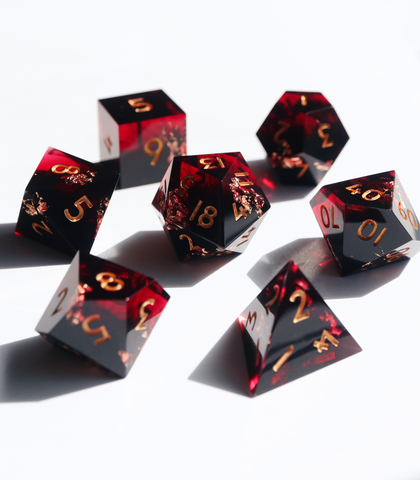The Ultimate Guide to DnD Orcs
How to Use This Iconic Fantasy Monster and Roleplay the 5e Race
Title image © Nicholas Wood-Smith
ORCS!!!!!
Excuse the following mouth-full... but they're the most famous fantasy evil minion mob there is.
No orcs? No modern fantasy.
Which is exactly why every new player wants to kill one ASAP, and probs why so many start as a human fighter; they can't WAIT to kill orcs just like Aragron.
But DnD 5e veterans know that after about 3rd level, the standard 5e orc starts to lose its bite. Players stop saying "Oh SH%T, orcs!" and start saying "ugh... orcs again?" I mean, geez, by 6th level even a freaking war chief fails to strike fear in players' hearts. Which sucks, cuz everyone STILL wants to have fun killing DnD orcs, even if they are high-level demigods traversing the multiverse.
Well reader, I have GOOD news for you...
Not only can DnD orcs be fun at BOTH high and low levels, but you can build an entire CAMPAIGN around them!
In this ultimate guide that took me way, way, WAY too long to write, we will explore the various aspects of DnD orcs, from their appearance and biology to their culture, religion, and combat strategies.
Whether you are a player looking to role-play one as a character or a Dungeon Master seeking to create compelling encounters that are more than "it attacks" over and over and over again, this guide will provide you with the knowledge and insight you need!
Table of Contents
- DnD Orcs Basics
- DnD 5e Orc Monster... or People Group?
- Dnd Orc Height, Appearance, and Biology
- The Orc 5e Race in Other Campaign Settings
- The Religious Fervor of D&D Orcs
- DnD Orc Origins and Afterlife
- DnD Orc Gods
- Dungeons and Dragons Orcs Culture
- The Tribe
- Wagons and Lairs
- Mating and Breeding
- Raids and Warfare
- Combat with an Orc in DnD 5e
- How to USE DnD Orcs
- How to BEAT DnD Orcs
- Role-Playing an Orc or DnD Half-Orc Character
- Orc Personality Traits
- How Orcs Interact With Other Races
- Other Character Creation Tips
- Exploring the Variety of the DnD 5e Orc Race
- The Monster Manual DnD Orc Stat Blocks
- Volo's Guide to Monsters
- Conclusion
DnD Orcs Basics
As every nerd knows, the origins of orcs is not in European folklore or mythology... they were invented by none other than J.R.R. Tolkien! They were the evil creations of the Valar Morgoth, who tortured elves until their souls were corrupted and their bodies twisted. They are a bit shorter than humans but taller than dwarves, with hooked noses, gnashing teeth, and a rainbow of disease and rotting skin colors (ash grey, pale green, puss red, scab black... ya know... gross colors!). They are spawned from mud pits, mindless in the second age but capable of marching in formation in the third age.
These are the OG orcs... hordes of evil to be vanquished by the forces of good.
Depictions of orcs in World of Warcraft and Games Workshop (NOTE: while definitely not the same, these two sources share enough in common to group them together... get off my back!) are also a major source of inspiration behind DnD orcs. These orcs are NOT inherently evil, but are evil compared to the standards of civilized society; they raid, pillage, and plunder indiscriminately. But they have real culture: they exist in tribes, mate, raise families, and pass down traditions. They are also physically HUGE: at least 2x as strong and a foot taller than a human (don't quote me on that...) and with more piggish facial features.
DnD orcs are a combination of the two: much larger than humans (probably closer to the size of Uruk-kai) but with a blend of human and piggish features. They are born naturally, but not raised in families. They are not mindless... capable of simple tactics and logic... but are aggressive, strong, and violent.
DnD 5e Orc Monster... or People Group?
In the 1) current lore, 2) previous edition lore, 3) RAW alignment, and 4) in virtually ALL of classic fantasy... DnD orcs are EVIL. They are not misunderstood or victimized; they all serve objectively evil gods, do objectively evil things, and have objectively evil beliefs. That is why they are MONSTERS, an evil race in the game.
I would put them on par with Nazi and Soviet soldiers in WW2. Is evil woven into their blood stream like Gnolls? Absolutely not. But they are raised and immersed in a culture, religion/race, and ideology that is despicably wicked, causing them to not only do and justify evil things all the time, but feel GOOD about doing such evil things. In DnD, good and evil are real, tangible things.
Now, Volo's Guide to Monsters added the DnD orc playable race. And if you are playing an evil campaign, then there is no problem with playing an orc as a character... in fact, they are the perfect choice! But if you are playing a more traditional/standard campaign, where you are a group of good-aligned adventurers slaying a dragon to save a kingdom... then playing a DnD orc might be problematic.
RAW, every single DnD orc has an evil alignment... but WOTC can't stop your homebrew!
But all that said... some DMs/players/tables prefer a more nuanced view of fantasy race that reflects modern racial awareness and sensitivity. Translation: if you have a post-modern mentality, you may object to having purely evil races. Important note: this is a HOT debate throughout the DnD 5e community and fantasy enthusiasts, one that I am only touching briefly now.
Ultimately, it is up to your Dungeon Master, who needs to clarify the nature of DnD orcs for the campaign setting to their players. After all, when coming across an orc village, murder hobos need to know if they should treat the orcs as evil (though cultured) monsters or a people group with their own perspective on life.
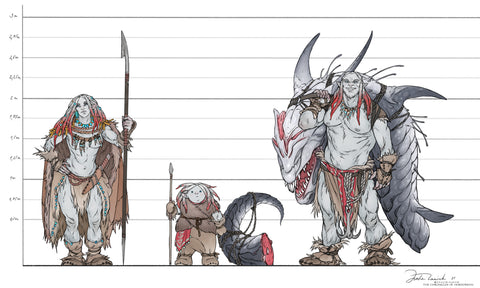
© Eva Zarich
Dnd Orc Height, Appearance, and Biology
This race/monster is distinct enough to stand out in a crowd. Their size is IMPOSING: DnD orcs are tall, most standing over 6 feet tall and some reaching 8 feet or more... walking with a hulking/hunched posture. And DND ORCS ARE STROOOOONG, weighing at least 230 lbs of pure muscle (BIG ones over 300lbs). For comparison, the AVERAGE DnD orc is the size of the Hound in Game of Thrones, capable of cleaving through a horse with a single great sword.
Orcs typically have green, brown, or grayish skin with thick, tufted black hair (though, in my games, I cannot help but give them red hair too). They have sloped heads with broad noses, and their faces tend to have scars, tattoos, and piercings. Finally, the most distinctive facial feature is their lower canines, or tusks, which vary in size and shape.
The Orc 5e Race in Eberron, Wildemount, and Other Campaign Settings
While orcs are a staple of any fantasy and DnD diet, they are not uniform; DnD orcs vary depending on the campaign setting. In the Eberron setting, orcs are the oldest humanoid race, and the most spiritual version of orcs in DnD 5e. They have three distinct types: Ghaash'kala (protectors of the Demon Wastes), the Jhorash'tar (warlike), and the Shadow Marches (very traditional). In the world of Wildemount, orcs are the NEWEST race. They have origins similar to those in Lord of the Rings, being born from tortured elves, but they are not inherently evil. And in Dragonlance there are no orcs at all (replaced by Draconians, their version of dragonborn)! The Forgotten Realms ones are the "standard DnD orcs" and their nature, tactics, and culture will be explored in more detail throughout this guide.
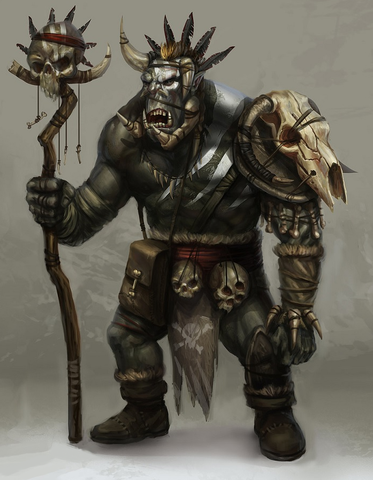
© Epic Path
The Religious Fervor of D&D Orcs
I considered putting DnD orc culture before religion in this blog post... but every which way I structured it, it was utter nonsense.
Why?
BECAUSE ORCS ARE RELIGIOUS AF.
Religion is involved in EVERY aspect of orc life. They claim their pantheon is active and present everywhere in the world, and it is the job of their various priests to discern the will of the gods through all sorts of divination and rituals and signs. You CANNOT understand DnD orcs apart from their religion.
DnD Orc Origins and Afterlife
5th edition DnD orcs are the creation of the god Gruumsh and his mate, Luthic (more on them in a moment...). But why are DnD orcs the way they are? Why can't they just, ya know, chill out?
There are two myths that explain why orcs kill, both of which make the elven chief deity, Corellon Larethian, look like a complete asshat. Either Corellon:
A) Purposefully prevented Gruumsh from having a homeland for his people.
B) Mocked Gruumsh's misfortune and shamed him in front of the other gods.
C) Shot him in the eye with an arrow during a fight.
D) All the above.
Regardless, Corellon INFURIATED Gruumsh against the hosts of heaven, and in response he swore that his people would RIP AND TEEEEEAR!!!!!!! They would fight elves, dwarves, halflings, humans... EVERYONE... taking their lives, loot, and land. Their conquest would not only prove that they are the greatest of all peoples, but that Gruumsh is the greatest of gods... it would be a perfect revenge worth waiting an eternity to exact. Are these myths true? The orcs certainly believe so, with every fiber of their being. So... that is why orcs fight everything all the time... and all that fighting means that they die a lot. So what happens when they die?
Guess what? MORE WAR!!! When DnD orcs die, their souls appear on the Layer of Nishrek on the plane of Acheron, where they fight alongside Gruumsh and his OTHER eternal foe, Maglubiyet (though the reason for their fight might be as simple as "That guy is like me... so I hate that guy").
Ok... so who are Gruumsh and Luthic anyways?

© AlexSturdee
DnD Orc Gods
Gruumsh "One Eye"
There is nowhere else to start than with Gruumsh: the chief deity. As you can see from the picture above, he is the god-version of the archetypal DnD orc: big, tough, angry, and violent. In fact, he is considered strong even by the standards of GODS; few deities have a better PR at bench press than Gruumsh!
Given that he has been around since the very beginning of Dungeons and Dragons, it follows that there is A LOT of lore about him. How much of it applies to 5e? Who knows. Volo's has scant information on him. So in a paragraph (or few), I'll try to synthesize what I feel are the essential elements... I apologize for the bias.
Called "One-Eye" due to his... well... one eye... which ceaselessly burns with rage toward his and his peoples enemies (elves and goblins, mostly). He carries his daunting "F-YOU" weapon called Bloodspear, which can not only grow in length as he sees fit, but also drips with the blood of elves. I cannot stress this enough... he REALLY hates elves.
(Side note: his Forgotten Realms page has a great explanation as to why: the elves are gentle and yet still deadly, which is an affront to everything DnD orcs stand for. That, and Corellon can't give a single f^ck about Gruumsh's strength, which... ya know... doesn't go over to well).
Gruumsh is strong and angry, but while his eye is always open, he is also metaphorically shortsighted. This is a guy that does not consider the long game or indirect approach. He has his principles, but his passionate rage will dictate where that attention is, and how those principles are, applied. Ironically, once he enters his rage, he becomes effectively blind to anything that isn't right in front of him.
Concerning his people, Gruumsh is confusing. On the one hand, the 'divine energies' he infuses DnD orcs and their tribes with naturally leads to disunity, as does as his clear favoritism and harsh retribution. On the other hand... he is relentless as he strives for their survival and honor, and his primary desire in life is that his people may thrive. Does he love them? Not really... but he clearly CARES.
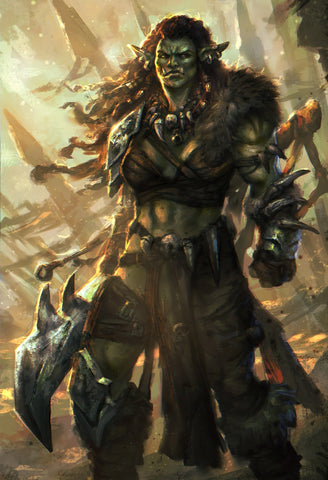
© Matthew Fletcher / Art © Manthos Lappas
Luthic "The Cave Mother"
Luthic is the "wife" of Gruumsh (though as we shall see, orcs do not "wed," only "mate"), and she is the one who LOVES the orcs, looking after their survival rather than conquest. Gruumsh uses the orcs to pursue his goals of vengeance, but Luthic has no such ulterior motive. Grummsh may give his people purpose, but he also pushes them into the jaws of death. Luthic does no such thing: her priestesses bring orcs into the world, raise them up, teach them to live, hold them together, and then usher them into the afterlife when their time has come.
That said, she is still a DnD orc deity... so while she draws each orc into her burly arms, defending them like a momma bear... she is also teaching her baby bears to avoid the honey and become ruthless killing machines instead. And when a tribe is directly threatened, it is Luthic who shows Gruumsh the true meaning of FURY: it is foretold that many enemy GODS will have their tongues, eyes, and ears torn out as Luthic defends with unrelenting wrath.
Luthic, the goddess of fertility, encourages orcs to reproduce and replenish their numbers. She creates a sense of unity among DnD orcs, reminding them that they are all one people, and that regardless of the strength of any particular champion, even they would be weak and ineffective apart from the tribe. Only together can they overcome all their enemies and succeed in the lofty goal of DOMINATING EVERYONE. Finally, she ensures raids can, you know, HAPPEN: she leads them in crafting, forging, and building, ensuring the tribe survives no matter what loot returns.
The Other DnD Orc Deities
While all DnD orcs follow/appease Gruumsh and Luthic, there are a few other niche deities that set apart some orcs from a tribe to serve them with a special attention. More information is found on them later in the blog (in the section "Exploring the Variety of the DnD 5e Orc Race").
- Yurtrus: "The While Hand," rot-covered DnD orc god of disease and death.
- Ilneval: "The War Maker," is the lieutenant of Gruumsh's forces, brings tactics and strategy into their raids and warfare.
- Bahgtru: "The Leg Breaker," the son of Gruumsh and Luthic, who embodies raw physical strength and sheer force of will.
- Shagras: "The Night Lord" is... I dunno, he just seems like an evil asshole. Not sure why he is a DnD orc deity, but he is! He hates all other deities, including Gruumsh, and all the orcs in the tribe fear and despise his followers.
DnD orcs fully believe 1) they are the children of Gruumsh and Luthic, 2) they should be confident in their ways, and 3) that they are the greatest of races born from the greatest of gods.
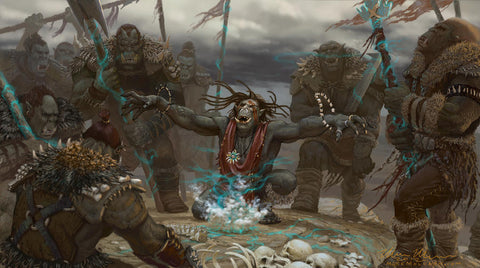
© Markmolchan
Dungeons and Dragons Orcs Culture
Fight the inferior... master all environments... fear the gods... from constant raiding to the very layout of the camp, these are the three tenets that dominate DnD orc culture. Every day of their lives revolve around raids, reproduction, and revenge, resulting in a warlike culture that is unique throughout D&D 5e.
The Tribe
The fundamental center of DnD orc culture is the tribe. Every command and activity is performed with the flourishing of the tribe in mind. It supersedes everything, sometimes even RELIGION: once in a while, a tribe will abandon their gods and follow a being of immense power they encounter, serving as their foot soldiers. This is often a dragon or giant, but can even be something like a demon or devil.
DnD orcs follow a strict hierarchy, lead by a strong male war chief who must constantly prove his strength and martial prowess... often in the form of defeating rivals. He is very "outward" facing, focused on raids and the eternal goals of orcs. The actual lair is sometimes organized/commanded by a "chosen one of Luthic" (more on that later). The final holders of power are then several shamans of different cults that are not only to be revered, but are ceded power for their particular domain. Due to the raiding and consumption demands a tribe places on a region, it can never exceed a few hundred members.
While all 5e orcs share a common religion, structure, and overarching vision, each has their own flavor of rituals, "branding" (colors, symbols), and superstitions to avert the wrath of their gods. DnD orc tribes also vary considerably in size, strength, short-term goals, and territorial holdings. These often conflict with rival tribes, which is what makes orc hordes so alarming: the tribes were not only able to stop fighting each other, but found a common goal to justify combining their forces. True nightmare fuel.
There are no scholars among DnD orc tribes. In fact, there is barely a written language. Orcs will use colors and simple phrases upon trees, animal skins, and anything big enough to communicate simple ideas to one another... stuff like "that swamp is cursed" or "already raided."

© Simon Zhong for Thea 2: The Shattering
Wagons and Lairs
DnD orcs are semi-nomadic; whenever they have exhausted the wealth and natural resources of an area, they pack up all their tents, gear, and loot to find somewhere else to conquer/pillage. This constant moving around is why they prize their war wagons so much. These vehicles are simple and not pretty to look at... "engineer" is not an acceptable occupation for an aspiring orc child... so all wagons are stolen from other cultures. They are often outfitted with orcish armor and religious iconography, and carry the ever-increasing piles of loot.
However, once in a while a tribe will come across a location... like a dwarven hold or city ruins... that is too good to pass up. Maybe the surrounding area is particularly rich in vulnerable villages or wild game. Or maybe the terrain is has excellent natural defenses. Regardless, when coming across such a spot, DnD orcs will remain for years, if not decades. Each camp/lair will have the following:
- The camp is divided based on religion: the default is Gruumsh, but if service or devotion is stronger for any particular deity, then that orc goes to that part of the camp.
- There is always a giant bonfire/hearth in the middle of the camp. It represents Gruumsh's rage, and its coals can never grow cold.
- There is always a designated place for shrines to the gods.
- Fighting pits are necessary for DnD orcs to train and demonstrate their strength.
- There is a separate space protected and run by the priestesses of Luthic who raise the young and watch over the food supply.
- Pens for giant bats, aurochs, boars, or captured livestock.
Mating and Breeding
Orcs are considered "teens" by age 4, full grown adults at age 12, and can live to age 40, but their violent lifestyle means the average lifespan is around 25. Additionally, Luthic demands they reproduce and constantly replenish their numbers, and this is never a problem... 5e orcs have a unique approach to reproduction, with males moving on to find another mate after achieving conception. In other words, there are no families in DnD orc tribes; males and females are completely indifferent to one another as soon as "the deed is done."
DnD orc children are not raised by parents... in fact, they likely have no idea who their parents are! As soon as they are born, they are taken by the priestesses of Luthic to be raised with the other tribe children in whelping pens. Their entire young lives are proving themselves worthy of Gruumsh: constant competition and feats of strength. They do not "grow up" and there is no nurturing... only discipline and instruction as they are trained and tested. The weak are abandoned, killed, or handed to the cults of Yurtrus or Shaagras.
Whether they disregard racial purity entirely, or whether their genes are just stronger than all the other humanoid races, DnD orcs reproduce with each other and other species as often as possible. These frequent matings between orcs and other races results in the birth of half-orcs, further diversifying the makeup of the tribe.
Side note... DnD orcs are evil... and they like breeding... and there are lots of half-orcs in the worlds of Dungeons and Dragons. It does not take a genius to conclude that many of those half-orcs were the result of non-consensual sexual encounters when humanoid men and women were kidnapped and forced to copulate. This is morally repugnant in the real world and is disturbing to actively imagine for many players. It is important to note that such topics should be approached with great care by Dungeon Masters. Each DM needs to establish and communicate the level of intensity of such themes in their campaigns, and make adjustments based on player comfort and the tone of the game. It is not unheard of to ban the topic from your table entirely.
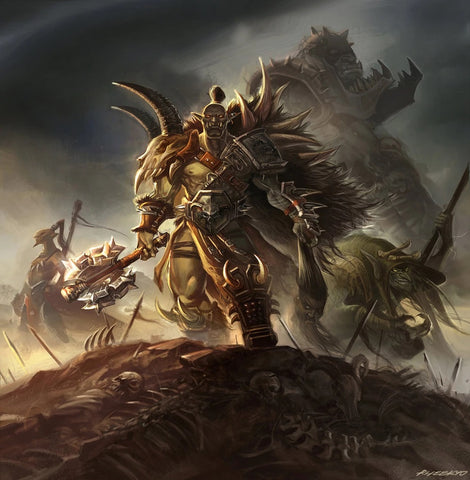
Karnione Wiki
Raids and Warfare
The infamous raid... burning settlements, looting supplies, and capturing people for slaves and sacrifices. You could say that the DnD orc tribe exists to make raids as frequent and efficient as possible. These raids pose a constant threat to neighboring communities... and is often the call to adventure for your players!
So who goes on these raids? Only the best. Though DnD orc males tend to be larger than females, it is size and strength... rather than gender... that dictates who goes on the raids. Skill matters too, but none in the tribe are lacking: all orcs have waged some sort of war the moment they could hold a butter knife.
DnD orc raiding parties strike with burtal force, appearing out of nowhere and killing anyone who opposes them. But it is not just killing... loot is also proof of their devastation of the other races. But what is the primary motivation for the raids: does the urge burn in their bones? Are they blinded by bloodlust? Are they greedy and desperate to prove themselves? Does the reason change depending on the particular tribe?!?
For inspiration, Dungeon Masters can draw from historical examples of raiding cultures. Apache tribes treated raiding almost like a game and EXPECTED retaliation. Before believing it was their divine destin to conquer the world, Mongol tribes raided both the Chinese and each other, and could easily be bought off. The Vikings were similar, but were also often looking for fertile land to settle and to establish trading posts. IMO, it's up to the DM.
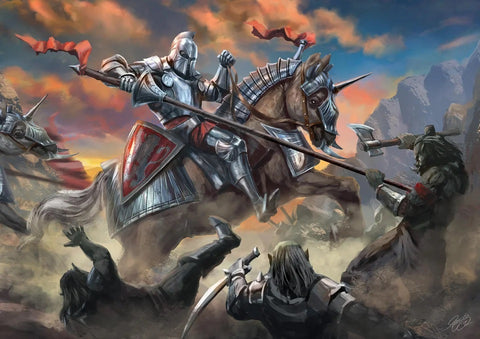
© Entar0178
Combat Encounters with Orcs DnD 5e
Onto the thing that DnD orcs do better than anything else... hacking, slashing, piercing, bludgeoning, beating, tearing, killing... COMBAT.
Long story short: if they get too close to you too quick, an encounter can get really deadly REALLY fast. Let's explore how they generally fight and offer guidelines for DMs and players alike.
Weapons of Orc Monsters
DnD orcs have high strength and not so high dexterity. So... mechanically... they are going to fight with exclusively strength-based weapons. Given their culture's lack of crafting ability, I'm guessing most of these weapons are taken from other races, are poorly maintained, or do not use an overwhelming amount of metal. As a result, I would say spears, axes, and clubs would be more popular with DND orcs than swords. Additionally, given their desire to dominate opponents and demonstrate their strength, most DnD orcs would favor two-handed weapons like battle axes over a single-handed weapons.
Culturally, they favor the bravery and triumph that comes from close-quarters combat, so their stat block in the Monster Manual only includes javelins for long-ranged weapons. That said, given their martial capabilities, I'm sure they are proficient with bows. In my games, I give them an abnormally large longbow that requires strength to shoot. They get -4 to their roll, but it deals a massive 2d8 damage.
Dungeon Masters: How to USE DnD Orcs
Disclaimer: this section is not about all the little strategies that come with the various mechanics of each DnD orc monster... that is in the section on DnD orc races. This is an overview... how do you, the DM, best introduce and use orcs in combat encounters? It includes some homebrew mechanical suggestions that make the orcs more interesting, especially for higher-level parties.
The "Aggressive Feature": This tells you everything you need to know about orcs... they CHARGE. Every turn, they can use their bonus action to move an additional 15ft, which means at minimum they can move 45ft, and max 75ft. That is a HUGE movement advantage, one you should use to get them into melee combat as soon as possible. The longer they are out in the open, the more vulnerable they are to arrows and the arcane.
No Battle if Foreign: If DnD orcs are on the attack, then they know what they are doing. That means that even when improvising, they are naturally good in sieges, ambushes... actually every type of warfare mentioned in our types of battles post. They can trust their warlike instincts and will naturally make the correct split second decision... though "correct" = aligning with the will of Gruumsh.
NOT Mindless Beasts: DnD orcs are not mindless like 2nd age LOTR orcs... they recognize the fighting differences of their enemies. If they know they are going up against elves, they are bringing a shield. If they know they are fighting dwarves, they are bringing something that can increase their reach.
No Terrain is "Difficult": Gruumsh wants his orcs to take the mountains from the dwarves, the fields from the halflings, the forests from the elves, and the coasts from the humans. Translation: they can fight ANYWHERE. For that reason, I suggest experimenting with them having advantage on any saves to cross difficult terrain.
Darkvision: Every DnD orc can see in the dark better than the majority of the good races. It makes no sense for orcs to ever fight during the day. Every raid, ambush, and assault should take place at night.
Intimidating: A bunch of huge, minimum-6ft, minimum-230lbs orcs charging your encampment would be TERRIFYING. Their stat block gives them a +2 to intimidation, but I would add an ability that if orcs charge and yell, everyone within 45ft has to make a wisdom saving throw or use their movement to run in the opposite direction for one round.
For more ideas, check out Osprey Publishing's "Orc Warfare."

© Wizards of the Coast
Players: How to BEAT a DnD Orc
All that said... how do you, the player, best overcome an orc raid during your attempt at a long rest? Or an assault on an allied town? While each combat encounter comes with unique variables, there are five general rules to follow when fighting DnD orcs:
- Ranged Attacks: Since orcs excel at close-quarters combat, do everything in your power to keep your distance; utilize range attacks whenever possible for as long as possible. And if the orcs close the gap, pull out any weapons with reach, like lances and pikes.
- Mental Spell Saves: For most of the DnD orc monster stat blocks, the mental abilities are pretty low, particularly intelligence. Make sure your spellcasters prepare spells with wisdom and intelligence saves that can exploit the lower mental stats of orcs.
- Taunting: If a puny halfling challenges a DnD orc's pride, they are sure to abandon their post or position in fury. This is an excellent way to lure them to specific areas or to divide and conquer a larger raiding party, one smaller group at a time.
- Daylight: Unless everyone in your party has darkvision, never EVER attack orcs during the night as they will have every advantage.
- Find and Threaten Their Camp: This one is easier said than done, but if your DM is using the lore from Volo's (or this blog post), then the orcs in your campaign are not used to enemies assaulting their camp and should not be as organized. Furthermore, you don't have to wipe out the camp; if any of the priestesses/followers of Luthic believe the current leadership is unable to protect the tribe, they will demand a leadership or location change, killing the current leader themselves if they have to.
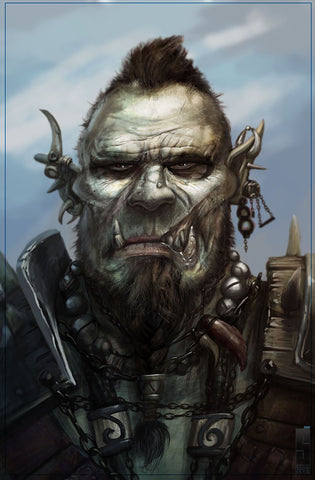
© Saad Irfan
Role-Playing an Orc or DnD Half-Orc Character
Ok, so I've written a lot about DnD orcs.. about their personality and religion and culture... and now you might be thinking: "Ya know... they sound pretty interesting... I'd REALLY like to play one in my next campaign." Or maybe you are a Dungeon Master who needs to scramble for the next session because, for SOME REASON, the gnome barbarian in the party rolled really high on an intimidation check and now the orc scouting party is impressed and willing to do some talkin'.
This section... ok, I'll be honest, it's a mish-mash of different things that didn't fit neatly into any of the other sections or in the FAQ. So it is going to flip flop between tips for character creation and tips for DMs and stuff like that. I trust you will follow along.
Orc Personality Traits
A great adage is "if it ain't broke, don't fix it." And while the personality/ideals/bonds/flaws element of 5e can certainly be improved... we can all admit that it certainly "ain't broke."
Pages 87–88 of Volo's Guide to Everything offers options for each of these role-playing categories. There are some bangers like "I drink the blood of monsters to consume their power" (personality), "Every serious choice I make must be decided by signs or omens from the gods" (bonds), and "I have a calm temperament and let insults roll off by back" (flaws). That last one could ONLY be considered a flaw to other orcs! So if you are looking to role-play a DnD orc, definitely start there.
But here are some other role-playing tips I could come up with:
Laconic Speech: The word "Laconic" comes from the Greek Spartans, who were famous for their one-liners. Everyone knows the "Then we will fight in the shade" line from 300, but there is an even BETTER one from the Macedonian wars. Philip II threatened that if he invaded, all sorts of terrible things would happen. The Spartan reply was one word: "If".... F-ing SAVAGE. I imagine DnD orcs would speak in a similar way: simple phrases LOADED with meaning.
Harsh Living: DnD orcs do not care so much for aesthetics or comfort. In fact, they may believe the harder the living, the tougher it makes them. So if the party is choosing a route to take, the orc would want the steepest, most dangerous hike. If they are laying our their bedrolls to sleep, the orc might CHOOSE to lay it out on a rocky surface, especially if they feel they disappointed Gruumsh that day.
Lack of Sentiment: Apart from religious relics, DnD orcs do not seem very attached to this or that item. Similar to a wacky video game RPG character who has a random assortment of the armors and armaments with the best stats, an orc character would be constantly dropping and picking up new weapons, armor, and gear. Remember, they do not really like to maintain their gear, so they might choose to just grab a new sword instead of sharpening their old one!
Of course, there are so many other things you can do. What horrible things do you think your DnD orc character finds funny? How do they treat a defeated foe? How do they communicate non-verbally with their size and strength? The deeper you go, the more interesting your character will be to you and the other players at the table.

How Orcs Interact With Other Races
As a general rule... DnD orcs hate everyone that is not an orc. They look at 'em, sneer, and say "I f-ing hate that guy..."
In the official lore, orcs are inherently racist, discriminating against and hating other races. Their disdain is drawn from both A) feelings of racial superiority and B) indignation that other races would resist/have treated orcs so poorly. But their anger is measured... not mindless. They seek to raid, loot, and conquer rather than commit genocide... UNLESS IT IS ELVES. Due to the orcs' founding mythology (remember the "Corellon is an asshat" stuff), elves are despised above all else, and orcs will actively search for elves and kill any they come across.
But with the other races, there are rare moments when they might engage in some sort of diplomacy. Here is my quick assessment of their overall impressions of the other main races:
- Equally strong races like Goliaths and Dragonborn inherently have the respect of DnD orcs... though orcs also see them as threats and rivals, or as targets to demonstrate their own strength.
- On the topic of strength... ettins and lycanthropes... orcs admire them so much they might have one or two in their tribe.
- Dwarves have mixed lore, and I tend to believe orcs harbor no particular dislike for dwarves, but COVET their strongholds. As a result, DnD orcs have no problem slaughtering every single dwarf if it means having a mountain fortress to call their own.
- IMO orcs are wary of innately magical races like tieflings or anyone that is a wizard or sorcerer, viewing their non-religious arcane powers with suspicion or fear.
- Every single elf and goblinoid has been nominated for lethal action by Gruumsh, with no exception. The kill order is etched in stone.
- Gnomes and halflings would be seen as perfectly useful slaves: not big enough to lead any sort of resistance and perfectly suited for chores around the tribe.
- Lastly, that leaves humans, and I have listened to some quality content that claims orcs share a strange kinship with humans. Why? BECAUSE THEY ARE SIMILAR. Both reproduce, both expand, both conquer, both take from other races and make their own... and humans do it while still being much smaller physically. That said, DnD orcs are even inclined to welcome particularly evil humans into the tribe, serving as tacticians, spies, or even as a chief!
Other Character Creation Tips
Best DnD Orc Class: Cleric and Barbarian
Gruumsh is the most Barbarian Barbarian that has ever Barbarian-ed. His violent instincts, short-sighted logic, and RAAAAAAGE basically commands all DnD orcs to be barbarians. And while a dwarven cleric and an orc cleric look very different (a lot less shining plate armor and a lot more rotting skulls), the hyper-religious structure of DnD orc society and variety of unique gods/oaths makes orcs a perfect fit for a hard-hitting priest.
Worst DnD Orc Class: Wizard and Bard
I mean... this seems self-explanatory... you can make anything work, but these are a stretch. While a Orc of Yutrus Necromancer does sound kind of cool, everything about the orc screams "not-book-smarts." And while DnD orcs may have a complex society, they would be beyond socially inept in tiefling, elven, human (etc.) societies. Their bardic music would sound too aggressive, their charm would be too aggressive, and their passion would be... yep... to aggressive (though I am sure you can come up with a different kind of bard with this blog post...).
Volo's or Mordenkainen
Apart from the racial customization feature present in just about everything since the release of Tasha's, the two racial stat blocks have a few key differences. Volo's version provides two additional skills and keeps the aggressive feature found in the monster stat blocks. But Mordenkainen's Monsters of the Multiverse gives the orc race not only a version of the aggressive feature (turning it into a dash action they can only use a number of times equal to their proficiency bonus during a long rest) but ALSO gives them the Relentless Endurance feature the half-orc race has. In my opinion, this option makes more sense.
Common DnD Orc Names
Orc names in Dungeons & Dragons are often guttural and harsh-sounding, reflecting the rugged and violent nature of the race. Common names include Grommash, Draga, and Zargoth, each evoking strength and intimidation. Volo's Guide to Everything includes a list of 12 female and male orc names, but you can find hundreds of names on sites like Fantasy Name Generator. Choosing an appropriate DnD orc name can help convey the character's personality, cultural background, and the formidable nature of the orc race.
What is the Difference Between an Orc and a Half-Orc?
It's literally in the name... half-orcs are 1/2 orc blood. They have one "parent" as an orc and another parent as some other race. It is implied that orcs breed true: anything they breed with results in a half-orc, with perhaps a few unique features.
That said, half-orcs are usually 1/2 human and combine the physical traits of both. They often face prejudice and rejection due to their heritage. Players that choose half-orcs get to explore the duality of their character's identity, balancing their orcish strength and attributes with human qualities and perspectives. The intense racial tensions between orcs and other races can lead some half-orcs to become leaders of orc tribes, thanks to their increased human traits and ability to bridge the divide between the races.

Exploring the Variety of the DnD 5e Orc Race
This section talks about the variants of orc monsters throughout the official, published WOTC books. If you combine them into different raiding parties, tribes, hordes... and apply the combat principles from before... I guarantee you DnD orcs will remain interesting monsters until your players reach at least level 10.
I will first summarize the lore and mechanics of each varient, and then will offer my opinion on how to best use them in your campaigns.
The Monster Manual DnD Orc Stat Blocks
DnD 5e Orc Stats (CR 1/2)
In the Combat with an Orc section, I covered how to use the most rudimentary, CR 1/2 orc in your campaign. Here are the basic stats. Long story short, you know how every marine is a rifleman? So to is every orc a warrior.
That said, this is only CR 1/2... a goblin is CR 1/4. Do you think a DnD orc is only twice as good as a goblin? Yeah, me neither. I think they are at least 4x better, which is why I would only use the standard stat block for the WEAKEST of DnD orcs; the ones that are injured or old and perform menial tasks around the camp.
War Chief (CR 3)
Within DnD orc tribes, the war chiefs are the undisputed leaders; their word is law and they have final say. Their cunning, strength, and ruthlessness has manifested in clear blessing from Gruumsh, as reflected in their stats. These guys have a +4 to STR, CON, and a +3 to CHA. Additionally, they have a "Battlecry" ability that they an use 1/Day, which allows all orcs within 30ft to gain advantage on all their attacks until the start of the war chief's next turn.
Personally... I think this is pretty weak for a war chief... not exactly a "scary, powerful leader of orcs." I would use his for the low level "officers" of a tribe, the leaders of raiding parties or units within a larger force. If you do that, maybe lower their hit points a bit.
Eye of Gruumsh (CR 2)
Our first taste of a DnD orc spellcaster! These are the orc shamans MOST devoted to Gruumsh... so much so that they must gouge out their own eye to serve him! Once they do, Gruumsh grants them additional bonuses to intelligence via dreams and visions over a period of months. That is, unless horrifying visions drive them to madness! But they are still DnD orcs after all, so while having limited spellcasting (only 3rd level), they still have all the martial traits too.
You'll notice a pattern, but I feel these are a bit underpowered and would not role-play them as the primary shamans in the tribe. Instead, I would use these as the personal guard of the war cheif. Even if just one is present, it can cast "Bless" on the war chief and then further protect him with "Spiritual Weapon."
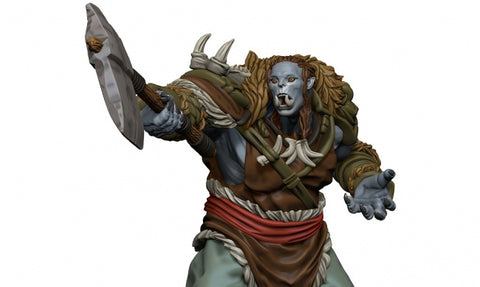
© NECA/WizKids, LLC
5e Orogs (CR 2)
This section is going to be a little chunky... because the lore changes drastically from MM to VgtM. Originally, the 5e Orog was just a chunky, psychopath DnD orc, but Volo's made them WAY more interesting, so we are going to go with that one instead...
First of all, they are a BIG DEAL for a tribe. They are not only born bigger and stronger, but also CALMER and SMARTER. They can think steps ahead and keep a cool head in many situations. Any orc can become a priestess of Luthic... but Orogs are BORN. And when they are born, they are usually whisked away to protect them from the jealous, anxious eyes of the war chief. But even though war chiefs always fear them, they really have nothing to fear; Orogs have no intention of leading the tribe in Gruumsh's endless wars... they are merely concerned that the tribe SURVIVE.
Orogs never go on raids because their job is to act as Luthic would: protect all orcs and keep everyone together, even from the more violent orcs. They lead the fashioning of blades, crafting, supplying for young and warriors alike, and raising every new generation. It is their job to MAINTAIN, not to expand. But when necessary, like if some wood elves were to attack the camp, they will not hesitate to enter into a jealous rage and rip the invaders apart limb from limb. They are known to keep bears as pets to reflect their nature as "momma bears" of the tribe.
I think there are two ways to use this Orog stat block:
- Make this the stat block for normal DnD orcs... the ones that do the most fighting.. tho maybe get rid of the armor and lower the AC to 15.
- Make them the muscle that protects the "priestesses" of Luthic, always remaining at camp to protect the young and the tribe.
Volo's Guide to Monsters DnD Orc Stat Blocks
Bahgtru Orcs
As stated in the gods section, Bahgtru is the son of Gruumsh and Luthic and is OBSESSED with proving his brute strength. This is the god that loves throwing weapons aside to break an enemy's neck with his bare hands. Very "Samson killing philistines with the jawbone of a donkey"-esque. Ruthless, savage sh*t like that. Just as he is constantly trying to prove his worth to Gruumsh, so the orcs invoking him are attempting to prove themselves to the tribe. That said, there are no stat blocks for these young orcs, though it is mentioned that they are known to ride aurochs (very large bison-type creatures) into battle.
Blade of Ilneval (CR 4)
Ilneval is the right-hand deity of Gruumsh, the tactical mind behind his wars. He reflects the reasonable side of Gruumsh: like him, he carries a bloody weapon (sword), but rather than screaming, he beckons worthy orcs to sit quietly with him by the fire, hearing example after example as they learn the best way to attack an enemy given any number of variables.
And his chosen DnD orcs serve in the same function for the war chief of the tribe. They are smarter, think a step ahead, and as a result serve as commanders in raids and wars. Mechanically, the Orc Blade of Ilneval has the ability to order orc forces within 120ft to attack as a free action.
If a Blade of Ilneval is present, the DnD orcs your players are facing should fight with a different style. Don't get me wrong, they can still be infuriated and emphasize brute force, but their combat strategy should be a lot more than just "charge." They should flank, surprise, and have complex goals that go beyond killing and looting. It is only when a Blade of Ilneval is present that DnD orcs will tactically retreat.
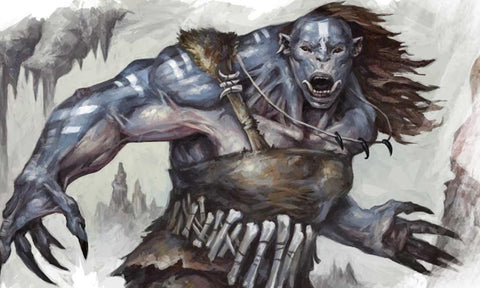
© Wizards of the Coast
Claw of Luthic (CR 2)
The Orc Claw of Luthic is a revered title among orc tribes, symbolizing a connection to the goddess of fertility and the protection of the young. Female DnD orcs marked by the Claw of Luthic serve as priestesses of the tribe, nurturing and guiding orcs from life until death. They are the voice of Luthic herself, the guardians of orc society, defending their tribes and embracing the violent and ruthless aspects of orc culture.
These monsters are so, so, so, so fun! They are 5th level spellcasters, but their spells are all over the place, having a damage spell and every useful "Bestow Curse," but many more that reflect their role as caretakers (Mending, Guidance, Cure Wounds, Create Food and Water). But remember... Luthic is a CAVE BEAR mother... and her priestesses often grow thick claws, paint them black, and use them as weapons when necessary.
Hand of Yurtrus (CR 2)
The Orc Hand of Yurtrus is an esteemed title given to orc spellcasters who follow the god of disease and death. After the priestesses of Luthic tend to a passing orc, they take the corpse to the priests of Yurtrus. These priests perform their rituals and sacrifices to turn the bones of great warriors into relics to be venerated and talismans to be wielded. They also tend to particularly diseased orcs, turning them into "Nurtured Ones of Yurtrus" to unleash and spread plague upon unsuspecting enemy settlements (they explode when they hit 0 hp).
These orc wizards specialize in necromantic and death-oriented magic. Their spells support the raiding parties by hindering and hampering their targets. Though only a 4th level spellcaster, they have both "Blindness/Deafness" AND "Silence," excellent spells for shutting down any spellcasters in your players' party.
Fang of Shargaas (CR 3)
The Orc Fang of Shargaas represents the orc rogues and scouts dedicated to the worship or Shargaas, the orc deity of darkness and murder. These orcs are evil, even by orc standards, and they have an obsession with stealth, darkness, and secrets. They ritually sacrifice AND DEVOUR weak orcs in the dark recesses beyond the outskirts of camp. This cult is an embarrassment for orcs, lacking all honor and strength and having more pure hatred than pure rage... but they can be useful.
To me, these DnD orcs do not make much sense, but mechanically they fill the role of scouts and assassins for tribes. They can cast "Darkness" once per short rest and have the rogue class's "Cunning Action" ability. And this scimitar attack deals 3d6, which is similar to low level sneak attack damage.
Tanarukk (CR 5)
Tanarukks are a fearsome and powerful race, half-breeds of orcs and demons. Yes... you read that right... these are DEMON ORCS. They possess dark red skin, horns, and a tail, and due to heir demonic heritage, they gain 1) magical resistance and 2) get advantage when attacking ANYONE that has hit them with a melee attack. Orc tribes, sometimes shunning or even killing Tanarukks at birth, may also keep them as powerful heavy infantry or use them strategically as shock troops. They often turn on their creators, and the pantheon despises when war chiefs try to spawn these abyssal abominations... so, basically, trying to get one never ends well for the tribe.
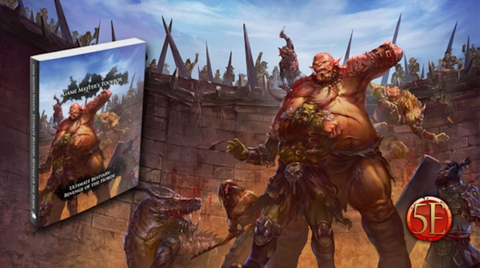
© Nord Games
Additional Variants
I strongly recommend picking up Ultimate Beastiary: Revenge of the Horde. It includes higher level options of DnD orcs AND other mob monsters. I would use its following stat blocks for different orcs:
- Orc Battleborn (CR 1) and Orc Bruiser (CR 3) as young orcs that follow Bahgtru.
- Orc Shaman (CR 4) as the chief priest of Gruumsh for the tribe.
- Orc Berserker (CR 5) as an Orog if someone tries to attack the camp.
- Orc Warlord (CR 6) as a beefier replacement for the war chief.
Conclusion
DnD orcs are RICH with flavor. They are violent, pious, evil brutes and a perfect enemy mob monster for nearly any 5e campaign. By understanding their complexities beyond mere fantasy stereotypes of LOTR or Warhammer, you can breathe life into your storytelling and role-playing experiences. Embrace the diversity of orc types, from Orogs to Yutrus, and let their unique traits inspire your adventures!
Riley Rath

Riley is a freelance tabletop games copywriter, content writer, and marketer based out of Spokane, WA. When not playing or writing about board games or DnD, he is busy with family, hiking, cooking, and gardening... very hobbit-like for a 6'4'' dude.



